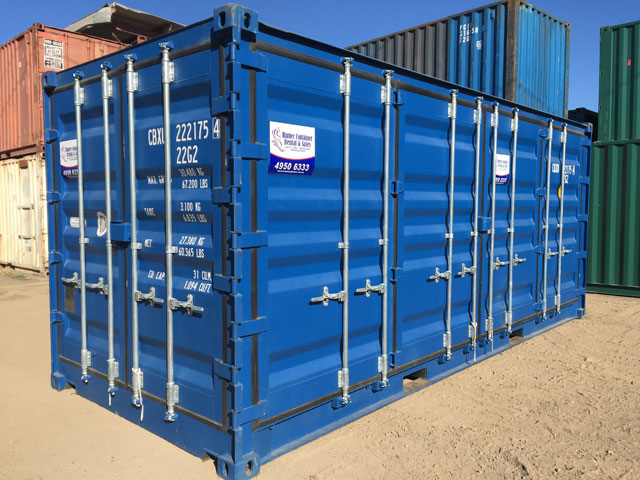Shipping containers are a popular storage solution in Australia, offering a robust and secure option for everything from business inventory to personal belongings. However, it’s crucial to understand that not everything should be stored in a shipping container. Just because it can fit doesn’t mean it should. This guide outlines what items to avoid storing in shipping containers to keep your possessions safe and sound.
Hazardous Materials: A Definite No-Go
One of the biggest no-nos is hazardous materials. This includes anything flammable, explosive, or corrosive – think paints, chemicals, petrol, propane tanks, and even some cleaning supplies. The dangers of storing flammable liquids in shipping containers are significant. Picture a hot Aussie summer: the container heats up like an oven, potentially causing these materials to ignite or leak, creating a serious fire risk for your container and surrounding properties. It’s simply not worth the risk. Dispose of these items responsibly through your local council’s hazardous waste program.
Perishable Goods: A Recipe for Disaster
Perishable goods are another category to avoid. Food, especially fresh produce, spoils quickly in the fluctuating temperatures inside a shipping container. The heat accelerates decomposition, attracting pests and creating a rather unpleasant (potentially hazardous) situation. Nobody wants to open their container to a wave of rotting food smells! If you need to store food items, use methods specifically designed for food safety. Similarly, avoid storing anything susceptible to extreme temperatures, such as certain medications or sensitive materials.
Sensitive Electronics: Prone to Damage
Sensitive electronics are also not recommended. While they might seem safe tucked away, temperature fluctuations and humidity can damage delicate circuitry. Computers, TVs, stereos, and cameras are best kept in a climate-controlled environment.
Art, Antiques, and Historical Items: Need Special Care
Art collections, historical pieces, and valuable antiques require specific environmental conditions for preservation. While shipping containers offer security, they often lack the necessary temperature and humidity control, potentially leading to damage over time. For artwork, in particular, the risk of warping or fading makes specialised storage a safer choice.
Pest-Attracting Items: Inviting Trouble
Pests are another consideration. While shipping containers are generally secure, they aren’t entirely impenetrable. Rodents and insects can find their way in, especially if there’s anything remotely edible stored inside. Avoid storing anything that might attract pests, and inspect your container regularly.
What Can You Store? Plenty of Options
So, what can you store in a shipping container? Quite a lot, actually! Furniture, tools, sporting equipment, seasonal decorations, and business inventory are all commonly stored in shipping containers. Just remember to follow best practices for shipping container storage safety, including proper ventilation and securing items to prevent shifting during transport. Smart packing is key to maximising your space. Research tips on how to pack a shipping container to make the most of your space.
Choosing the Right Container: Size Matters
Storing items in shipping containers can be an excellent way to manage your belongings, especially with the wide range of long-term storage containers available. However, knowing what not to store is just as important as knowing what to store. Consider your storage needs and choose the right size.
Do you need a smaller storage solution? A 10-foot storage container is ideal for seasonal decorations, garden tools, or other smaller items. Its compact size offers convenient storage without taking up excessive space, and it’s often a more budget-friendly option.
Shipping containers offer practical and secure storage solutions, from decluttering your home to managing business inventory. Betta Storage containers in Sydney have a variety of options. Ready to maximise your storage space and enjoy the benefits of organised and secure storage? Contact us today for a free consultation!

1. Site Selection
If you are not mounting the container for the long term, choose a spot where the ground is even and the soil firm and compacted so that it will support the frame of the container. If your site is rough or slanted you can add a layer of gravel or small stones to keep the container stable and secure.
2. Surroundings
If your container is going to remain in place for a length of time, it can be valuable to pave the surrounding area prior to installation. This will provide a solid firm base for your structure and will enable you to utilise the outer area of the container more easily.
3. Vehicle Access
If your site is in a position behind other buildings then you may have trouble getting your container to your site. There are options to have your container dropped in situ’ by a crane but this is expensive. If your site is accessible by vehicle you will keep delivery costs down. Setting up storage containers in Sydney, where the topography varies, it is a great idea to prepare a level area prior to delivery.
4. Weather conditions
It is ideal to have your container delivered on a day free of rain, after a dry spell. Installing your container directly onto sodden earth may lead to sinkage and misalignment of your final structure. If you are in a particularly rough area you may need to secure your shipping container to the ground, but in most circumstances, the natural weight of the container will hold it firmly in place.
5. Ventilation
If you are concerned about water or drainage around the site of your container then it may be worthwhile setting the container down on concrete blocks. This will keep it raised from ground level, free of moisture and well ventilated.
Betta Storage are your local Sydney specialists in movable new and used storage containers. Contact us to discuss your requirements and let us help you choose the right container for your needs.

